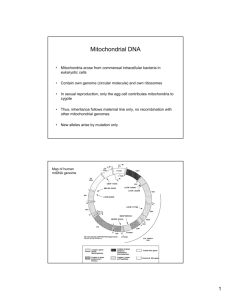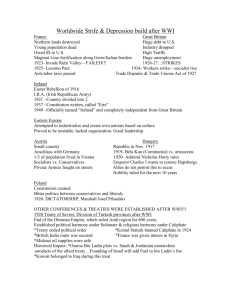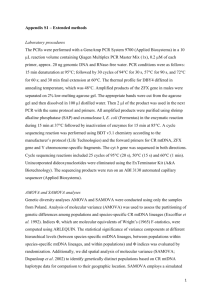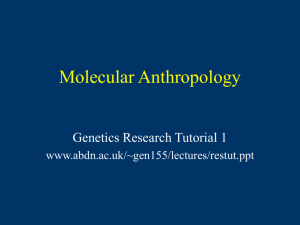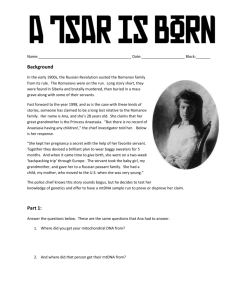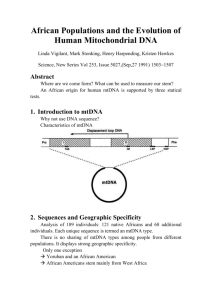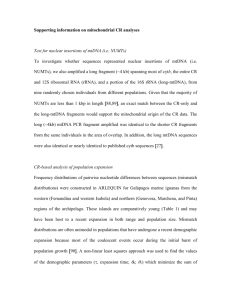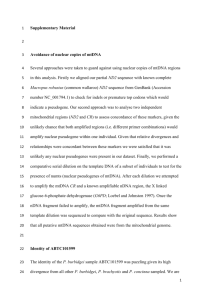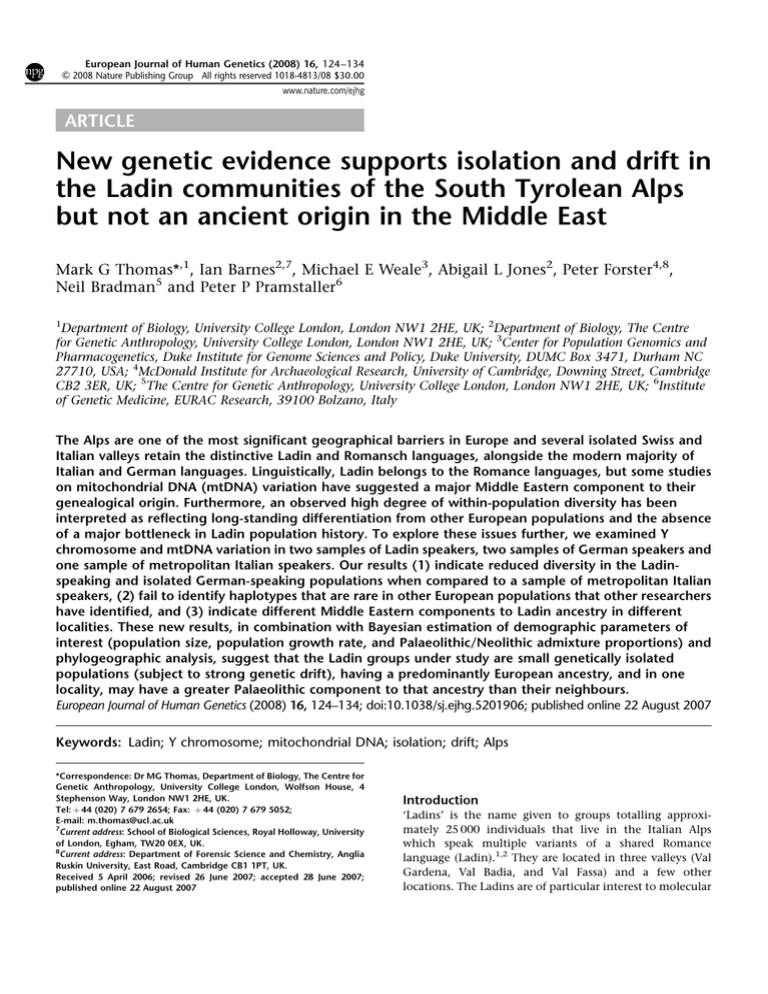
European Journal of Human Genetics (2008) 16, 124–134
& 2008 Nature Publishing Group All rights reserved 1018-4813/08 $30.00
www.nature.com/ejhg
ARTICLE
New genetic evidence supports isolation and drift in
the Ladin communities of the South Tyrolean Alps
but not an ancient origin in the Middle East
Mark G Thomas*,1, Ian Barnes2,7, Michael E Weale3, Abigail L Jones2, Peter Forster4,8,
Neil Bradman5 and Peter P Pramstaller6
1
Department of Biology, University College London, London NW1 2HE, UK; 2Department of Biology, The Centre
for Genetic Anthropology, University College London, London NW1 2HE, UK; 3Center for Population Genomics and
Pharmacogenetics, Duke Institute for Genome Sciences and Policy, Duke University, DUMC Box 3471, Durham NC
27710, USA; 4McDonald Institute for Archaeological Research, University of Cambridge, Downing Street, Cambridge
CB2 3ER, UK; 5The Centre for Genetic Anthropology, University College London, London NW1 2HE, UK; 6Institute
of Genetic Medicine, EURAC Research, 39100 Bolzano, Italy
The Alps are one of the most significant geographical barriers in Europe and several isolated Swiss and
Italian valleys retain the distinctive Ladin and Romansch languages, alongside the modern majority of
Italian and German languages. Linguistically, Ladin belongs to the Romance languages, but some studies
on mitochondrial DNA (mtDNA) variation have suggested a major Middle Eastern component to their
genealogical origin. Furthermore, an observed high degree of within-population diversity has been
interpreted as reflecting long-standing differentiation from other European populations and the absence
of a major bottleneck in Ladin population history. To explore these issues further, we examined Y
chromosome and mtDNA variation in two samples of Ladin speakers, two samples of German speakers and
one sample of metropolitan Italian speakers. Our results (1) indicate reduced diversity in the Ladinspeaking and isolated German-speaking populations when compared to a sample of metropolitan Italian
speakers, (2) fail to identify haplotypes that are rare in other European populations that other researchers
have identified, and (3) indicate different Middle Eastern components to Ladin ancestry in different
localities. These new results, in combination with Bayesian estimation of demographic parameters of
interest (population size, population growth rate, and Palaeolithic/Neolithic admixture proportions) and
phylogeographic analysis, suggest that the Ladin groups under study are small genetically isolated
populations (subject to strong genetic drift), having a predominantly European ancestry, and in one
locality, may have a greater Palaeolithic component to that ancestry than their neighbours.
European Journal of Human Genetics (2008) 16, 124–134; doi:10.1038/sj.ejhg.5201906; published online 22 August 2007
Keywords: Ladin; Y chromosome; mitochondrial DNA; isolation; drift; Alps
*Correspondence: Dr MG Thomas, Department of Biology, The Centre for
Genetic Anthropology, University College London, Wolfson House, 4
Stephenson Way, London NW1 2HE, UK.
Tel: þ 44 (020) 7 679 2654; Fax: þ 44 (020) 7 679 5052;
E-mail: m.thomas@ucl.ac.uk
7
Current address: School of Biological Sciences, Royal Holloway, University
of London, Egham, TW20 0EX, UK.
8
Current address: Department of Forensic Science and Chemistry, Anglia
Ruskin University, East Road, Cambridge CB1 1PT, UK.
Received 5 April 2006; revised 26 June 2007; accepted 28 June 2007;
published online 22 August 2007
Introduction
‘Ladins’ is the name given to groups totalling approximately 25 000 individuals that live in the Italian Alps
which speak multiple variants of a shared Romance
language (Ladin).1,2 They are located in three valleys (Val
Gardena, Val Badia, and Val Fassa) and a few other
locations. The Ladins are of particular interest to molecular
Isolation and drift in the Ladin communities
MG Thomas et al
125
anthropologists because mitochondrial DNA (mtDNA)
sequence data have been used to argue that they are
genetically differentiated from both neighbouring and
other European populations and are highly diverse in
terms of within-population mtDNA sequence variation.3 – 5
Stenico et al3 and Stenico et al4 argued that the high
internal diversity they identified is inconsistent with the
view that isolation, low effective population size, and
subsequent genetic drift had brought about Ladin genetic
differentiation from neighbouring populations. Instead
they postulated that the differences are the result of
differing patterns of settlement in alpine versus non-alpine
surrounding regions before the establishment of the Ladin
language, followed by some degree of isolation but without
any major population bottleneck events. Furthermore,
based on comparisons of the distribution of mtDNA
hyper variable segment 1 (HVS1) sequence haplotypes in
Ladins with those in other populations, and specifically
on the high incidence of mtDNA haplogroup T (previously
known as haplogroup 2; 63, 25, and 36% in Val Gardena,
Val Badia, and Val Fassa samples, respectively), which is
relatively rare in Europe but common in the Middle
Eastern, they proposed a large Middle Eastern component
to Ladin origins. However, the mtDNA sequence data
quality on which these conclusions were based has been
questioned.6 – 8 Substitutions at key sites were found on
multiple branches of the mtDNA HVS1 network, despite
being rare in other European populations. These substitutions have been described as ‘phantom’ mutations6 and
have been attributed to systematic sequencing errors.
In an attempt to address concerns about data quality,
Vernesi et al5 collected and analysed a further sample
(n ¼ 20) from Colle Santa Lucia (see Figure 1), one of the
two locations from which the samples analysed by Stenico
et al3 were collected. Vernesi et al5 did not report sequences
from any re-sampling from Selva Val Gardena/Wolkenstein.
Although Vernesi et al5 reported differences from
the earlier Colle Santa Lucia set (Fisher’s Exact Test for
Population Differentiation:9 P ¼ 0.038, comparison made
in this study) and accepted the possibility of sequencing
errors, they nevertheless concluded that the principal
conclusions reached by Stenico et al3 stood, that is
‘Ladin-speaking inhabitants of the Alps do display a high
internal mitochondrial diversity, and that they are one of
the main European mitochondrial outliers.’
Recently, Marroni et al10 investigated variation in Ladin
and surrounding populations at a number of X-linked
markers. They identified high linkage disequilibrium in
Ladin samples and a high degree of differentiation both
among different Ladin populations and between those
populations and non-Ladin-speaking groups living in
surrounding valleys. These results raise the possibility that
Ladin differentiation is due to isolation and small population size, leading to high rates of genetic drift. Given the
importance of the conclusions reached by Stenico et al3
Innsbruck
AUSTRIA
SWITZERLAND
GVU
LVB
GVL
LVG
ITA
ITALY
Milano
LSL
Trento
50 km
Venice
Figure 1
Map of the South Tyrol region in North Eastern Italy,
showing the locations of the populations sampled for this study (LVG,
LVB, GVU, GVL, ITA) as well as the location of Colle Santa Lucia (LSL)
which was sampled by Stenico et al3 and by Vernesi et al5.GVL,
German speakers from lower Vinschgau (Latsch) and surrounding area;
GVU, German speakers from upper Vinschgau (Laas/Prad/Stilfs); ITA,
Italian speakers from Bolzano and the surrounding area; LVB, Ladin
speakers from Val Badia; LVG, Ladin speakers from Val Gardena.
and Stenico et al,4 involving prolonged isolation of a
substantial population in south-central Europe displaying
a Middle Eastern origin, we have investigated whether
alternative explanations of Ladin demographic history
are more plausible. In this study, we analysed mtDNA
sequence data from the hypervariable region 1 (HVR1) of
two further collections of Ladins and compared them with
(a) neighbouring German (two sample sites) and Italian
(one site) speakers to assess respective levels of genetic
diversity and similarity and (b) multiple European and
Middle Eastern populations (to assess the relative contributions of putative source populations to the five sample
sets). We also undertake similar analyses of the paternally
inherited non-recombining portion of the Y chromosome.
The South Tyrol: history, languages, and people
The South Tyrol region of the Alps contains a number of
communities separated from one another by mountainous
terrain. Three main languages; Italian, German, and Ladin,
are spoken among them, together with a number of related
dialects.2 Ladin, like Italian but unlike German, is a
Romance language and, along with Romansch (spoken in
eastern Switzerland) and Friulian (spoken in northeast
Italy), belongs to the Rhaetian sub-group of the Italic
branch of Indo-European languages. Although Ladin
speakers alive today are mainly confined to three valleys,
two of which are located in the South Tyrol region (Val
Gardena and Val Badia), the distribution of toponyms
(place names) suggests that Rhaetian languages were more
European Journal of Human Genetics
Isolation and drift in the Ladin communities
MG Thomas et al
126
widely spread during the early Middle Ages.11 The region
in which the Ladin now live was incorporated into the
Roman Empire only in around 15 or 16 BC (sometime after
northern France (50 BC) but before Britain (43 AD)). German
colonists are thought to have arrived following the fall of
the Roman Empire in the 5th century AD.12 Today most
non-Ladin-speaking groups in the South Tyrol, for which
Italian is not their first language, speak German. The
Italian speakers of the South Tyrol are found mainly in
larger towns or cities, and their presence is largely the
result of immigration encouraged by the Italian government after the detachment of South Tyrol from Austria in
1918, a practice that continued until the end of the Second
World War.13
Materials and methods
Samples
Buccal swabs were collected from a total of 263 men from
the South Tyrol region, comprising a sample of 59 Italian
speakers from Bolzano and the surrounding area (ITA), 56
Ladin speakers from Val Badia (LVB), 46 Ladin speakers
from Val Gardena (LVG), 52 German speakers from lower
Vinschgau (Latsch) and surrounding area (GVL), and 50
German speakers from upper Vinschgau (Laas/Prad/Stilfs)
(GVU) (see Figure 1). Donors were selected only if their
grandfathers were from the same region and they were
unrelated to other donors at the grandfather level. Swabs
were stored in a DNA preservative solution containing
0.5% sodium dodecyl sulphate and 0.05 M ethylenediaminetetraacetic acid for transport purposes and DNA was
purified by phenol – chloroform extraction/isopropanol
precipitation. Samples were collected anonymously and
informed consent was obtained from all individuals before
samples were taken. To investigate Ladin variation in
mtDNA, we also used the data published by Vernesi et al5
relating to a sample from the Ladin occupants of Colle
Santa Lucia.
Molecular analysis
The mtDNA HVS-1 was sequenced as described previously.14 Sequences were obtained from all samples
between positions 16008 and 16400 according to the
numbering scheme of Anderson et al.15 mtDNA haplotypes were assigned to haplogroups (Mhg) for the purpose
of admixture analysis only (see below) by identifying key
combinations of HVS-1 mutations according to Macaulay
et al,16 Richards et al,17 and Maca-Meyer et al18 as follows:
16069T, 16126C ¼ Mhg-J, 16069T, 16126C, 16145A,
16261T ¼ Mhg-J1, 16224C, 16311C ¼ Mhg-K, 16126C,
16294T ¼ Mhg-T, 16126C, 16163G, 16186T, 16189C,
16294T ¼ Mhg-T1, 16126C, 16294T, 16304C ¼ Mhg-T2,
16126C, 16256T, 16292T, 16294T ¼ Mhg-T3, 16249C ¼
Mhg-U1, 16051G ¼ Mhg-U2, 16343G ¼ Mhg-U3 16356C ¼
Mhg-U4, 16270T ¼ Mhg-U5, 16172C, 16219G ¼ Mhg-U6,
European Journal of Human Genetics
16298C ¼ Mhg-V, 16223T, 16292T ¼ Mhg-W. For the remaining haplotypes, those with a T at position 16223 were
assigned to Mhg-MNL and those with a C at position 16223
were assigned to Mhg-HVR.
Y chromosomes were typed in all samples for six
microsatellites (DYS19, DYS388, DYS390, DYS391,
DYS392, and DYS393) and 11 Unique Event Polymorphism
(UEP) markers (92R7, M9, M13, M17, M20, SRY þ 465,
SRY4064, SRY10831, sY81, Tat, and YAP) as described
previously.19 In addition, the UEP marker 12f2 was typed
as described by Rosser et al.20 Microsatellite repeat numbers
were assigned according to the nomenclature of Kayser
et al.21 Y-chromosome haplogroups, defined by the 12 UEP
markers, were classified according to the nomenclature
proposed by the Y Chromosome Consortium.22 Their
genealogical relationships are presented in Supplementary
Figure S1.
Statistical and population genetic analysis
Unbiased genetic diversity (h) and its standard errors were
calculated using the formulae given by Nei.23 Tests for
the significance of differences in h-values were carried
out using two methods. The first was a standard two-tailed
z-test and the second was by bootstrap re-sampling. As a
conservative measure, only the larger of the two P-values
was used.14 To correct for multiple comparisons of h-values
between different Ladin and non-Ladin population samples, we bootstrap re-sampled mtDNA and Y-chromosome
haplotypes 10 000 times and calculated, in each case, the
proportion of times that the average Ladin h-value was
greater that the average non-Ladin h-value. As an conservative measure, we then multiplied the higher P-value
by two as two tests were performed (one for mtDNA and
one for Y chromosome). Tests for the significance of
among-population differences in the within-population
mean pairwise difference (MPD) for mtDNA sequences
were carried out by bootstrap re-sampling 100 000 times.
Populations were compared for differences in the distribution of haplotype and haplogroup frequencies using
the genetic distance measure FST,24 and for differences in
the distribution and molecular divergence of Y-chromosome microsatellite haplotypes using RST,25 estimated from
Analysis of Molecular Variance FST values,26 and using
the Fisher’s Exact Test for Population Differentiation.9 The
significance of pairwise FST and RST values was assessed by
permuting haplotypes 10 000 times, and 10 000 Markov
steps were used in the Fisher’s Exact Test. All of the above
analyses were performed using ARLEQUIN software.27
Patterns of genetic differentiation were visualized using
classical multidimensional scaling, also known as Principal
Coordinates Analysis,28 performed on a pairwise FST
matrix, as implemented in the cmdscale command of the
statistical package ‘R’ (URL: http://www.R-project.org/).
Admixture proportions were estimated using the likelihood-based method LEA29 [LEA can be obtained by
Isolation and drift in the Ladin communities
MG Thomas et al
127
contacting L Chikhi (e-mail: chikhi@cict.fr) or M Beaumont
(e-mail: m.a.beaumont@reading.ac.uk)], based on Y-chromosome data alone, mtDNA data alone, and the
Y-chromosome and mtDNA data sets combined. The
combined analysis was performed under the assumptions
of equal male/female demographic histories and equal
effective population sizes. While these assumptions are
unlikely to hold, the procedure provides gender-averaged
estimates of demographic parameters that can be compared among populations. Since LEA does not model
mutation and in our experience appears to have convergence problems when a large number (430) of alleles are
considered, only Y-chromosome haplogroup and inferred
mtDNA haplogroup frequencies were used. Because no
significant difference was observed between the two German-speaking populations (see Results and Table 1), we
grouped these two samples together and treated them as a
single population sample (GV). However, because the two
Ladin samples were significantly different from one
another in their distribution of mtDNA and Y-chromosome
haplotypes using the Fisher’s Exact Test of Sample Differentiation,9 we analysed them separately. We used unpublished Y-chromosome haplogroup frequency data for 179
Anatolian Turks (data available on request), as well as 57
Biscay Basques and 44 Guipuzcoa Basques.30 We combined
this with published data from Rosser et al20 on 26 Basques
and from Bosch et al31 and Perez-Lezaun et al32 on 50
Basques, giving comparable Y-chromosome haplogroup
frequency data for 177 Basques. Because the same
Y-chromosome UEP markers were not typed in all Basque
samples, it was necessary to collapse haplogroups N3 and
L (defined by the presence of derived states at loci Tat
and M20 respectively) to their ancestral haplogroup,
haplogroup K*(xL,N3,O2b,P) in both cases. Previously
published mtDNA HVS-1 sequence data from Richards
et al17 on 218 Anatolian Turks and 156 Basques was
used. Most of the Anatolian Turk samples used by Richards
Table 1 FST values based on mtDNA HVS1 sequence
haplotype frequencies (upper right) and on Y-chromosome
UEP+microsatellite haplotype frequencies (lower left)
GVL
GVL
GVU
ITA
LVB
LVG
0.00529
0.000330
0.0281*
0.0328*
GVU
ITA
LVB
LVG
0.00647
0.00651*
0.00331
0.0172*
0.0126*
0.00742*
0.0343*
0.0324*
0.0232*
0.0349*
0.00428
0.0541*
0.0396*
0.0387*
0.0292*
0.0264*
Significant values (Po0.05) are shown in bold.
The * symbol indicates significant differences (Po0.05) in haplotype
frequencies using the Fisher’s Exact Test of Sample Differentiation.
Abbreviations: GVL, German speakers from lower Vinschgau (Latsch)
and surrounding area; GVU, German speakers from upper Vinschgau
(Laas/Prad/Stilfs); HVS1, hyper variable segment 1; ITA, Italian speakers
from Bolzano and the surrounding area; LVB, Ladin speakers from Val
Badia; LVG, Ladin speakers from Val Gardena; mtDNA, mitochondrial
DNA; UEP, unique event polymorphism.
17
et al
are the same as those used here to generate
Y-chromosome data. We ran 600 000 Monte Carlo iterations of the coalescent simulation and discarded the first
10 000 iterations as burn-in.
Demographic parameters of interest (population size and
growth rate) were estimated from Y-chromosome data
under a model of exponential growth (‘size model’ 1),
using the Bayesian inference program BATWING (URL:
http://www.maths.abdn.ac.uk/;ijw).33 We ran 102 000
Monte Carlo iterations of the coalescent simulation and
discarded the first 2000 iterations as burn-in. Population
demographic priors were: initial effective population
size – gamma(1.1,0.0001), growth rate – gamma(1.01,1), time
growth starts (in generations) – uniform(0, time to most
recent common ancestor),34 final population size – uniform(0, 50 000). Locus-specific priors for the mutation rate
per generation were based on observed mutations.34 These
were: DYS19 – Gamma(3,1459), DYS390 – Gamma(5,929),
DYS391 – Gamma(3,878), DYS392 – Gamma(2,878), and
DYS393 – Gamma(1,878). As a precautionary measure,
DYS388 was excluded from BATWING analysis because no
published data on observed meioses are available for this
locus. Population size and growth rate were estimated from
mtDNA HVS1 sequence data analysed under a model of
exponential growth using the Bayesian inference program
BEAST v1.2, (URL: http://evolve.zoo.ox.ac.uk/beast/).35
Each population was analysed under a model of exponential growth, with an upper limit for population size of
50 000 and a mutation rate of 3.6 106 mutations/site/
generation,17 under a HKY þ G model of nucleotide
substitution.36 We ran 200 000 000 Monte Carlo iterations
to ensure that convergence had been achieved and that
effective sample sizes were above a lower limit of 100 for all
parameters. Post-processing of LEA, BATWING and BEAST
outputs was carried out using the statistical package ‘R’
(URL: http://www.R-project.org/).
The geographic spread of South Tyrolean mtDNA
haplotypes was quantified and visualized using the
mtRadius database,8 currently containing data from over
24 000 individuals. A centre-of-gravity (COG) analysis37
was carried out using a minimal sequence range between
positions 16093 and 16362,15 leaving a total of 19 493
individuals active in the database, of which approximately
12 000 were from Europe and surrounding areas. The
method considers the worldwide geographic distribution
of each sequence type individually, and optionally selects
only those sequence types as reliable markers of origin
which have a restricted geographic spread, measured as the
mean distance of the haplotypes from their centre of
gravity. Canary Islanders were excluded since they are
mostly recent (post-1450s) immigrants from Spain, Italy,
Britain, and elsewhere and would therefore obscure ancient
geographic distributions rather than assist in describing
them. This left a total of 17 917 individuals active in the
database. COGs were calculated as described in Forster
European Journal of Human Genetics
Isolation and drift in the Ladin communities
MG Thomas et al
128
et al,37 and are based on at least two matches in the
mtRadius database, with the frequency grid size set to 2
degrees of longitude by 2 degrees of latitude. As with the
admixture analysis, because no differentiation was observed
between the two German-speaking populations, we grouped
the two samples (GV). However, because the two Ladin
samples were significantly different from one another, we
analysed them separately. For comparison, we also applied
the COG analysis to 100 Anatolian mtDNA sequences,
consisting of 50 randomly chosen Anatolian Turks and 50
randomly chosen Anatolian Kurds from mtRadius database,
and removed those sequences from the active mtRadius
database when that analysis was performed.
Results
mtDNA data quality
Because of previously highlighted concerns about data
quality in published studies on Ladin mtDNA, we applied
the methods suggested by Bandelt et al7 as a check on the
quality of our mtDNA sequencing. We first restricted
analysis of the data set of 263 individuals (all the South
Tyrolean groups) to ‘weighty’ sites, as recommended by
Bandelt et al7 (these are sites where the mutation rate
appears relatively low). There were 40 such weighty sites.
The ratio of weighty transition sites to transversion þ indel
sites (WTTI ratio) was 4.0 which is within the range
reported for other European data sets considered by
Bandelt et al7 to be reasonably problem-free. In addition,
the reduced-median network drawn from the ‘weighty’
data contained five two-dimensional cycles and no higherdimensional cycles, which is again within the range for
reasonably problem-free data sets of this size.
mtDNA and Y-chromosome diversity
A total of 111 mtDNA HVS1 haplotypes were observed in
the five population samples and these were clustered
into 17 haplogroups based on the occurrence of key HVS1 mutations (see Methods). The distribution of mtDNA
haplotypes is given in Supplementary Table S1, together
with the mtDNA haplogroup assignment. The Y-chromosome UEP markers defined seven observed haplogroups
(HGs) (see Supplementary Figure S1 and Supplementary
Table S2) and the UEP þ microsatellite markers defined a
total of 100 haplotypes (Supplementary Table S3). Two
instances of homoplasy of microsatellite haplotypes across
UEP haplogroups were observed (microsatellite haplotype 15 12 22 10 11 14 was found on two BR*(XDE, JR)
and one E*(xE3a) chromosomes, and microsatellite
haplotype 14 12 23 10 13 14 was found on one P*(xR1a)
and one K*(xL,N3,O2b,P) chromosomes; all microsatellite
haplotypes given in this paper are in the order DYS19,
DYS388, DYS390, DYS391, DYS392, DYS393). This is
consistent with other studies using similar numbers of
microsatellite loci.38 – 42
European Journal of Human Genetics
To test for non-random association of mtDNA and
Y-chromosome haplotypes among individuals within
populations, which might indicate within group structuring
or non-random sampling (such as sampling from multiple
individuals within the same family), we carried out an
extension of Fisher’s Exact Tests to RxC tables.43 Because of
the large number of mtDNA and Y-chromosome haplotypes present, all singleton mtDNA and Y-chromosome
samples were respectively grouped into a single class. No
significant association was found within any of the five
populations.
Gene diversities were compared using P-values based on
pairwise comparisons. mtDNA HVS1-haplotype frequencybased gene diversity values (see Supplementary Table S1)
were significantly lower in the Ladins as a whole than
in the Italian-speaking population (Po0.02), but not the
German speakers when treated as a single population
(P ¼ 0.16). Furthermore, in comparisons among the five
populations sampled, the two Ladin groups had the lowest
gene diversity with the Ladin Val Gardena group having
a significantly lower h-value than the Italian speakers
(Po0.005) and both German-speaking groups (Po0.04).
All other pairwise population differences in h-values based
on mtDNA HVS1-haplotype frequencies among the five
groups sampled were greater than 0.05. By applying a
correction for multiple tests to all five population samples,
we found that the average Ladin gene diversity was lower
than the average non-Ladin gene diversity in 499.99% of
bootstrap re-sampled mtDNA haplotype data sets. Similarly, in both language and individual pairwise population
group comparisons, the two Ladin samples displayed the
lowest MPD for mtDNA HVS1 (Supplementary Table S4)
although these differences were not significant when
tested by bootstrap re-sampling.
Y-chromosome h-values (Supplementary Tables S2
and S3) were significantly lower in the Ladins than
in the German or Italian-speaking populations at the
levels of haplogroup frequencies (Po0.003) and UEP þ
microsatellite haplotype (‘full’ haplotype) frequencies
(Po0.0003). A similar pattern was observed in pairwise
comparisons of the five groups (Po0.05), except that the
Val Gardena group was not significantly less diverse than
the Lower Vinschgau group at the haplogroup (P ¼ 0.13).
All other Y-chromosome pairwise population differences
in h-values were greater than 0.05. Correcting for multiple
tests among all five population samples (see above), we
found that the average Ladin gene diversity was lower than
the average non-Ladin gene diversity in 99.75% of bootstrap re-sampled Y-chromosome haplotype data sets.
Comparisons using various genetic distance measures
(FST, RST, corrected mean pairwise nucleotide difference)
and the Fisher’s Exact Test of Sample Differentiation,9 at
various levels of data (mtDNA sequence haplotypes,
assigned mtDNA haplogroups, Y-chromosome full
haplotypes, Y-chromosome microsatellite haplotypes and
Isolation and drift in the Ladin communities
MG Thomas et al
129
Estimation of current effective population size
and growth rate
We estimated population demographic parameters of
interest (current effective population size and population
growth rate), based on mtDNA HVS1 sequence data using
BEAST,35 and based on Y-chromosome data using BATWING.33 We analysed the two Ladin-speaking samples and
the Italian-speaking sample individually but, because no
differentiation was observed between the two Germanspeaking samples (see above and Table 1), we grouped
them together and treated them as a single population
(GV). Posterior estimates of current effective population
size and population growth rate based on mtDNA and
Y-chromosome data are given in Tables 2 and 3 respectively. To examine the difference in posterior estimates of
these parameters in different populations, we took 200 000
two-point draws of the parameter value from its separate
posterior distributions in populations #1 and #2, calculated
the difference (value in population #2 value in population #1) and calculated the proportion of instances that
were greater than zero. For the analysis based on mtDNA
data we found that 99.1% of GV, 99.0% of LVB, and 98.9%
of LVG posterior estimates of current effective population
size were smaller than those for ITA. We also found that
3.8% of GV, 8.6% of LVB, and 15.7% of LVG posterior
estimates of population growth rate were smaller than
those for ITA. For the analysis based on Y-chromosome
data, we found that 99.3% of GV, 99.99% of LVB, and
99.9% of LVG posterior estimates of current effective
population size were smaller than those for ITA, and
88.9% of GV, 90.2% of LVB, and 96.8% of LVG posterior
estimates of population growth rate were smaller than
those for ITA.
0.02
LVB
ο
PCO 2 (15.88%)
0.01
0.00
ITL
ο
GVU
ο
GVL
ο
LVG
ο
–0.01
–0.02
–0.02
–0.01
0.00
0.01
PCO 1 (82.99%)
0.02
0.03
0.02
PCO 2 (20.61%)
Y-chromosome UEP-defined haplogroups) indicated Ladin
isolation. The ITA, GVU, and GVL groups are closely
related to one another with the LVG and LVB groups more
distantly related, both from one another and from the
other three populations. While in pairwise comparisons
among the ITA, GVU, and GVL samples, none of the
genetic distance measures were statistically significant
(P40.05, unadjusted for multiple comparisons), genetic
distances between the two Ladin populations and the ITA,
GVU, and GVL populations were mostly significant and
large. Table 1 shows FST values for population comparisons
based on mtDNA HVS1-haplotype frequencies and
Y-chromosome full haplotype frequencies. These distances
are summarized in principal coordinate plots (Figures 2a
and b). The Fisher’s Exact Test of Population Differentiation, based on the same data, also indicates little
differentiation among the ITA, GVU, and GVL samples
(only the GVL/ITA groups mtDNA haplotype distribution
was significantly different), while the LVG and LVB groups
were significantly different from one another and the ITA,
GVU, and GVL samples.
LVG
ο
0.01
0.00
GVU
ο
ITL
ο
LVB
ο
GVL
ο
–0.01
–0.02
–0.03
–0.03
–0.02
0.00
0.01
–0.01
PCO 1 (79.39%)
0.02
0.03
Figure 2
Principal coordinate plots based on FST values for mtDNA
HVS1 haplotype frequencies (a) and for Y-chromosome full haplotype
frequencies (b). HVS1, hyper variable segment 1; mtDNA, mitochondrial DNA.
The origins of the Ladins: admixture analysis
Given the claim of a Middle Eastern origin for the Ladin
speakers,4 we investigated whether there are differences
among the five sample sets in the relative contributions
from (a) to the east, Anatolian Turks, who have been used
to represent Neolithic farmers, and (b) to the west, Basques,
who have been used to represent Palaeolithic huntergatherers.44 To do so, we applied the admixture-based
approach of Chikhi et al.29,44,45 While it is unlikely that
these are the only possible source populations,46 they do
represent convenient alternative options on which to
assess comparative contributions to present day European
populations.4 Posterior estimate modes of the Eastern/
Neolithic contribution were similar for the German and
European Journal of Human Genetics
Isolation and drift in the Ladin communities
MG Thomas et al
130
Table 2 Posterior estimates of current effective population size and population growth rate, based on mtDNA HVS1
sequence data only, using BEAST under a model of exponential growth
Population
Mode
ITA
LVB
LVG
GV
Current effective population size
95% CI
49 077
150
171
180
Mode
30 501 – 49 794
63 – 34 521
53 – 36 628
111 – 32 779
Population growth rate
95% CI
0.0018
0.0078
0.0034
0.014
0.0012 – 0.0029
0.00077 – 0.75
0.00023 – 0.55
0.0015 – 0.76
Abbreviations: HVS1, hyper variable segment 1; ITA, Italian speakers from Bolzano and the surrounding area; LVB, Ladin speakers from Val Badia; LVG,
Ladin speakers from Val Gardena; mtDNA, mitochondrial DNA.
Table 3 Posterior estimates of current effective population size and population growth rate, based on Y-chromosome data
only, using BATWING under a model of exponential growth
Population
Mode
ITA
LVB
LVG
GV
Current effective population size
95% CI
14 088
632
1420
2833
Mode
6646 – 47 489
347 – 2389
748 – 4903
1585 – 8775
Population growth rate
95% CI
0.013
0.0021
0.0024
0.0053
0.0062 – 0.031
0.00030 – 0.021
0.00038 – 0.012
0.0020 – 0.017
Abbreviations: ITA, Italian speakers from Bolzano and the surrounding area; LVB, Ladin speakers from Val Badia; LVG, Ladin speakers from Val Gardena.
Italian speakers when Y chromosome and mtDNA were
considered together. However, while the LVG sample
(mode ¼ 51%) was similar to the German and Italian
speakers (mode ¼ 56%), the LVB sample (mode ¼ 13%)
was very different. In comparisons with posterior estimates
of Eastern/Neolithic contribution to the LVB sample 88.28,
92.56 and 92.15% of the estimates for the LVG, German
speakers and the Italian speakers respectively were higher.
Analysis based just on the Y chromosome produced a
similar result. However, analysis of mtDNA alone revealed
extreme estimates for the two Ladin-speaking populations
with the LVB sample indicating the lowest contribution of
all the groups (mode ¼ 18%) and the LVG sample the
highest (mode ¼ 95%) (see Table 4 and Figure 3).
We also compared posterior estimates of the drift
parameters T/N1, T/N2, and T/Nh indicating the amount
of drift that has occurred in the Anatolian and Basque
putative source populations and in the admixed populations, respectively, since admixture. Consistent with
expectation based upon the timing of the acquisition
of agriculture, all modal estimates of drift were higher
for the Basques than for the Anatolian Turks. Consistent
with isolation in both Ladin-speaking populations and
the combined German-speaking population, all modal
estimates of drift (T/Nh) were higher than those for the
Italian-speaking population; for the combined Y-chromosome and mtDNA data sets, 88% of the Val Gardena, 82%
of the Val Badia, and 94% for the German speaker posterior
estimates of T/Nh were higher than for those for the Italian
speakers. When mtDNA or Y-chromosome data were
considered independently these values were 90, 91, 94,
and 58%, 69, 59%, respectively.
European Journal of Human Genetics
Table 4 Posterior estimates of Neolithic admixture
proportions (P1) together with 95% CI intervals, using LEA
Population Data
GV
LVG
LVB
ITA
GV
LVG
LVB
ITA
GV
LVG
LVB
ITA
mtDNA
mtDNA
mtDNA
mtDNA
Y
Y
Y
Y
mtDNA+Y
mtDNA+Y
mtDNA+Y
mtDNA+Y
P1 mean P1 median P1 mode P1 95% CI
0.48
0.70
0.42
0.36
0.51
0.39
0.27
0.53
0.56
0.50
0.22
0.54
0.47
0.75
0.39
0.33
0.51
0.37
0.22
0.54
0.57
0.50
0.20
0.54
0.34
0.95
0.18
0.25
0.54
0.35
0.089
0.55
0.56
0.51
0.13
0.56
0.031 – 0.95
0.16 – 0.99
0.024 – 0.94
0.024 – 0.86
0.066 – 0.94
0.036 – 0.88
0.012 – 0.80
0.076 – 0.94
0.21 – 0.89
0.15 – 0.87
0.016 – 0.57
0.22 – 0.83
Abbreviations: ITA, Italian speakers from Bolzano and the surrounding
area; LVB, Ladin speakers from Val Badia; LVG, Ladin speakers from Val
Gardena; mtDNA, mitochondrial DNA
Data used were inferred mtDNA haplogroup frequency, Y-chromosome haplogroup frequency, and inferred mtDNA haplogroup
frequency and Y-chromosome haplogroup frequency combined.
Geographic centre-of-gravity analysis of
mtDNA haplotypes
Applying the COG approach,37 the LVB, LVG, GV, and ITA
haplotypes appear to be predominantly of recent European
origin (see Supplementary Figure S2). Interestingly, a
number of the Ladin speakers had their matching mtDNA
haplotype COGs more clustered in the region of the Alps
than did either the German or Italian speakers. Only six
out of 102 Ladin speakers, three out of 102 German
speakers, and one out of 59 Italian speakers have their
COGs outside Europe. These outliers are likely to be due to
parallel mutations in the short HVS1 sequences considered
Isolation and drift in the Ladin communities
MG Thomas et al
density
131
1.5
0.5
0.0
0.2
0.4
0.6
0.8
1.0
0.0
0.2
0.4
0.6
0.8
1.0
0.0
0.2
0.4
0.6
0.8
1.0
density
2.0
1.0
0.0
density
3.0
2.0
1.0
0.0
P1
Figure 3 Estimated Middle Eastern admixture proportions (P1) for the LVB (solid lines), LVG (dashed lines), GV (alternately dotted and dashed
lines), and Italian-speaking (dotted lines) populations based on inferred mtDNA haplogroup frequencies only (a) Y-chromosome haplogroup
frequencies only (b) and both inferred mtDNA and observed Y-chromosome haplogroup frequencies combined (c). LVB, Ladin speakers from Val
Badia; LVG, Ladin speakers from Val Gardena; mtDNA, mitochondrial DNA.
here and would be expected to disappear with longer
sequences. For comparison, Supplementary Figure S2
shows a COG plot for 100 randomly selected Anatolian
mtDNA sequences. It should be noted that the data for
non-European populations are limited and, as such, these
analyses will be biased to an unknown extent.
Discussion
Data analysed in this study support different conclusions
from those reached by Stenico et al,3 Stenico et al,4 and
Vernesi et al.5 There is little sharing of haplotypes between
the Ladin samples included here and those presented
previously (using only data for the region of sequence
overlap – positions 16051 – 16362). Only two out of 18
haplotypes reported by Stenico et al3 were found among
the 40 Ladin haplotypes reported here. In the case of the
Vernesi et al5 study, 5 of the 10 haplotypes reported in their
paper were found among the 40 Ladin haplotypes reported
here (see Supplementary Table S1). In addition, the modal
mtDNA HVS-1 sequence in our Ladin sample, the Cambridge
Reference Sequence,15 was not found in any of the
previously published Ladin data sets. Likewise, the modal
mtDNA HVS1 sequence in the data set reported by Vernesi
et al5 was found in only two of the 56 LVB individuals and
none of the 46 LVG individuals. For comparison, 11 of the
40 Ladin haplotypes reported here were also found in our
German- and Italian-speaking samples. Despite the small
sample numbers reported in previously published studies,
all possible Ladin comparisons, except that of Stenico
et al’s3 Santa Licia and Val Gardena samples, indicated
significant sample differentiation by the Fisher’s Exact Test
for Population Differentiation.9 A second difference from
the previous studies is that we find lower diversity in the
Ladins than in their neighbouring populations, both in
terms of gene diversity (h) and within-population MPD.
When comparing all five populations investigated here, we
found that the average Ladin gene diversity was lower than
the average non-Ladin gene diversity in 99.75% bootstrap
re-sampled data sets. In part, these differences may arise
because only one location (Val Gardena) was sampled in
both this and the previous three studies for which data are
available. Despite the small sample size of the Stenico et al3
data (n ¼ 10), gene diversity for our Val Gardena sample is
significantly lower (P ¼ 0.015) (using only data for the
region of sequence overlapFpositions 16051 – 16362). A
third difference is that geographic analysis of the global
distribution of mtDNA HVS1 haplotypes presented here
using the COG approach and the mtRadius database37 does
not indicate an unusually large Middle Eastern component
to Ladin origins; nearly every Ladin mtDNA type has its
closest genetic match in Europe rather than elsewhere. Of
the few non-European outliers, both in the Ladin as well as
in the Italian and German mtDNA samples, none cluster in
the Near East and are best explained as chance matches
caused by parallel mutations in the short sequence range
considered. A potentially interesting feature distinguishing
Ladin from German and Italian mtDNA is that three
geographically specific Ladin types (found in 8 out of 102
Ladin individuals) are not common beyond the Alps. The
European Journal of Human Genetics
Isolation and drift in the Ladin communities
MG Thomas et al
132
German and Italian sequences do not demonstrate
such clustering. In contrast, the plot generated for 100
randomly selected Anatolian mtDNA sequences shows that
most haplotypes with a limited range (as indicated by black
circles in Supplementary Figure S2) have their COGs in
the Middle East. However, as discussed below, it should be
noted that while admixture analysis does not indicate a
high Middle Eastern component to Ladin ancestry overall,
the result for the Val Gardena mtDNA data does suggest an
unusually high contribution (mode ¼ 95%).
Significantly lower Y-chromosome diversity is also
observed in the Ladins when compared to the neighbouring populations analysed here, and the average Ladin
gene diversity was lower than the average non-Ladin gene
diversity in 499.99% bootstrap re-sampled data sets.
Furthermore, we find a relatively high degree of mtDNA
and Y-chromosome differentiation, quantified using FST,
both between the two different Ladin localities and also
between the Ladin localities and the neighbouring Italianspeaking and two German-speaking populations. The
most likely explanation for these observations is population isolation and a relatively small effective population
size, leading to strong genetic drift in the Ladins. This is
further supported by Bayesian inference of effective
population size based on mtDNA HVS1 sequence data
using BEAST, Y-chromosome data using BATWING, and by
LEA analysis, which all show that posterior estimates of the
effective population size are smaller (in the case of BEAST
and BATWING analysis, by wide credible margins) for the
Ladins than for the urban Italian speakers. The two
German-speaking samples also have smaller posterior
estimates of effective population size than the Italian
speakers. As both the Ladin speakers and the German
speakers were collected from isolated valleys, our study
supports the contention that the Alps present geographic
barriers that even today are reflected in the genetic makeup of the populations living there. This finding has also
been noted in other mountainous regions (for example in
mountainous parts of Armenia42).
The Ladin speakers sampled by Vernesi and colleagues5
were from a different location (Colle Santa Lucia) to those
sampled here. Considering that those sequences were
produced partly in response to a criticism of data quality,7
it seems unlikely that these data are also erroneous. While
the high diversity observed in the Vernesi data set is not
consistent with our general conclusion of high rates of
genetic drift in Ladin groups, the difference in distribution
of mtDNA haplotypes between their Ladin sample and
those presented here is consistent with isolation among
geographically separated populations. It is possible that the
very different conclusions drawn by our analyses are due to
genuine differences in the population history of Colle
Santa Lucia. However, the fact that we find significant
differences in the one Ladin group common to our study
and that of Stenico et al3 (Val Gardena), plus the existence
European Journal of Human Genetics
of other evidence for sequencing errors in those data
(Bandelt et al7), strongly suggest that, with respect to the
earlier Stenico et al3 paper, differences are due to laboratory-based artefacts.
Isolation and genetic drift will confound the task of
identifying potential source populations, particularly
when only a small number of loci are analysed. When
two potential source populations are proposed, admixture
analysis can be useful for estimating their relative contributions to the admixed population. Both Chikhi et al44
and Belle et al45 have used this approach to provide an
estimate of the relative contributions of Neolithic farmers
and Palaeolithic hunter-gatherers to various populations in
Europe, using Near Easterners and Basques, respectively, as
the descendents of their model source populations. Their
chosen admixture estimation method29 has the advantage
of allowing for, and providing an estimate of, the extent of
drift in the admixed population and both source populations subsequent to the (single) admixture event. Our
results are intriguing in that when mtDNA and Y-chromosome data are considered together, they suggest a larger
Palaeolithic component to LVB ancestry than any of their
neighbouring populations LVG, GV, and ITA. Examination
of admixture proportions based on individual loci
suggests that in this case the signal is mainly due to the
Y-chromosome data. It is tempting to postulate that a low
Neolithic component to LVB ancestry is the result of longterm isolation, with that population perhaps descending
from an in situ Palaeolithic population. However, we are
cautious of placing too much emphasis on the absolute
estimates resulting from admixture analysis for the following reasons: (1) The method assumes the correct identification of source populations that have not been influenced
by admixture themselves since the Neolithic, (2) different
effective population size and demography for mtDNA and
Y-chromosome data would violate the modelling assumptions of LEA when these loci are analysed together, (3) the
admixture estimation method employed cannot account
for mutation since the admixture event, (4) estimates of
admixture are typically wide and overlapping for the
four South Tyrolean populations, (5) it is highly unlikely
that any European population formed following a single
admixture event between incoming farmers and Palaeolithic hunter-gatherers. Of particular concern is the appropriateness of the source populations used, especially since
Alonso et al46 have recently questioned whether Basques
best represent Palaeolithic Europeans. Nonetheless, the
admixture approach, using Near Easterners and Basques as
source populations, has made an important contribution
to the ongoing debate of the origins of Europeans44,45
and, in the context of this study, serves to make useful
comparisons between the various South Tyrolean
groups. We note that for the LVG population, the mtDNA
and Y-chromosome admixture estimates are rather discrepant; when mtDNA data are considered alone admixture
Isolation and drift in the Ladin communities
MG Thomas et al
133
estimates suggest a higher Neolithic/Middle Eastern component to LVG ancestry than any of their neighbouring
populations. This is consistent with the findings of Stenico
et al3,4 but in contrast to the results of the COG approach
using the mtRadius database37 and the admixture estimates
based on Y-chromosome data alone. However, such a
discrepancy is within the range of expectation in a small
population experiencing high rates of genetic drift.
The high degree of differentiation between the two Ladin
populations sampled here is intriguing in that it suggests
a low level of gene flow between different localities, despite
shared cultural and linguistic features. Genetic isolation
among different Ladin populations is consistent with
recent studies of X-chromosome variation10 as well as the
highly tree-like phylogeny of regional Ladin languages,
which indicate a language fissioning process with
little subsequent vocabulary exchange.1 Perhaps, the best
explanation for this is that geography is the most
important isolating factor for the Ladins, and possibly the
two German-speaking populations. However, we cannot
rule out other processes such as local language replacement
and admixture from other source populations. If the
patterns of mtDNA and Y-chromosome variation observed
in the South Tyrolean populations do reflect long-term
isolation and a high rate of genetic drift, then this would
explain the high levels of linkage disequilibrium recently
observed.10 This could be potentially relevant to medical
genetic research.
Acknowledgements
We acknowledge the generous help of Drs Pizzecco, Scherer, Skocir,
Wallnöfer (Val Venosta), Capone, Corradini, Fontanella (Bolzano),
Kostner, Troebinger (Val Gardena), and Mahlknecht (Val Badia)
for collecting the buccal swabs. We thank HJ Bandelt for comments
on early drafts of the manuscript and advice on assessing mtDNA
sequence data quality. We also thank Drs A Drummond and A
Rambaut for providing advice on the use of the BEAST software, and
the two anonymous referees for their valuable comments.
References
1 Forster P, Toth A, Bandelt H-J: Evolutionary network analysis of
word lists: visualising the relationships between alpine romance
languages. J Quant Ling 1998; 5: 174 – 187.
2 Ruhlen M: A Guide to The World’s Languages. Stanford, CA:
Stanford University Press, 1987.
3 Stenico M, Nigro L, Bertorelle G et al: High mitochondrial
sequence diversity in linguistic isolates of the Alps. Am J Hum
Genet 1996; 59: 1363 – 1375.
4 Stenico M, Nigro L, Barbujani G: Mitochondrial lineages in Ladinspeaking communities of the eastern Alps. Proc R Soc Lond B Biol
Sci 1998; 265: 555 – 561.
5 Vernesi C, Fuselli S, Castri L, Bertorelle G, Barbujani G:
Mitochondrial diversity in linguistic isolates of the Alps: a
reappraisal. Hum Biol 2002; 74: 725 – 730.
6 Bandelt HJ, Lahermo P, Richards M, Macaulay V: Detecting errors
in mtDNA data by phylogenetic analysis. Int J Legal Med 2001;
115: 64 – 69.
7 Bandelt HJ, Quintana-Murci L, Salas A, Macaulay V: The
fingerprint of phantom mutations in mitochondrial DNA data.
Am J Hum Genet 2002; 71: 1150 – 1160.
8 Rohl A, Brinkmann B, Forster L, Forster P: An annotated mtDNA
database. Int J Legal Med 2001; 115: 29 – 39.
9 Raymond M, Rousset F: An exact test for population differentiation. Evolution 1995; 49: 1280 – 1283.
10 Marroni F, Pichler I, De Grandi A et al: Population isolates in
South tyrol and their value for genetic dissection of complex
diseases. Ann Hum Genet 2006; 70: 812 – 821.
11 Pellegrini GB: La genesi del Retoromanzo (o Ladino). Tübingen:
Niemeyer, 1991.
12 Leitner W: Die Urzeit; In: Fontana J, (ed).: Geschichte des Landes
Tirol. Innsbruck-Wien-Bozen: Athesia-Tyrolia, 1985, vol 1.
13 Parteli O: 1918 – 1970; In: Fontana J, (ed).: Geschichte des Landes
Tirol. Innsbruck-Wien-Bozen: Athesia-Tyrolia, 1985, vol 4.
14 Thomas MG, Weale ME, Jones AL et al: Founding mothers of
Jewish communities: geographically separated Jewish groups
were independently founded by very few female ancestors. Am J
Hum Genet 2002; 70: 1411 – 1420.
15 Anderson S, Bankier AT, Barrell BG et al: Sequence and organization of the human mitochondrial genome. Nature 1981; 290:
457 – 465.
16 Macaulay V, Richards M, Hickey E et al: The emerging tree of West
Eurasian mtDNAs: a synthesis of control-region sequences and
RFLPs. Am J Hum Genet 1999; 64: 232 – 249.
17 Richards M, Macaulay V, Hickey E et al: Tracing European founder
lineages in the Near Eastern mtDNA pool. Am J Hum Genet 2000;
67: 1251 – 1276.
18 Maca-Meyer N, Gonzalez AM, Larruga JM, Flores C, Cabrera VM:
Major genomic mitochondrial lineages delineate early human
expansions. BMC Genet 2001; 2: 13.
19 Thomas MG, Bradman N, Flinn HM: High throughput analysis of
10 microsatellite and 11 diallelic polymorphisms on the human
Y-chromosome. Hum Genet 1999; 105: 577 – 581.
20 Rosser ZH, Zerjal T, Hurles ME et al: Y-chromosomal
diversity in Europe is clinal and influenced primarily by
geography, rather than by language. Am J Hum Genet 2000; 67:
1526 – 1543.
21 Kayser M, Caglia A, Corach D et al: Evaluation of Y-chromosomal
STRs: a multicenter study. Int J Legal Med 1997; 110: 125 – 133,
141 – 129.
22 The Y Chromosome Consortium: A nomenclature system for the
tree of human Y-chromosomal binary haplogroups. Genome Res
2002; 12: 339 – 348.
23 Nei M: Molecular Evolutionary Genetics. New York: Columbia
University Press, 1987.
24 Reynolds J, Weir BS, Cockerham CC: Estimation for the
coancestry coefficient: basis for a short-term genetic distance.
Genetics 1983; 105: 767 – 779.
25 Slatkin M: A measure of population subdivision based on
microsatellite allele frequencies. Genetics 1995; 139: 457 – 462.
26 Excoffier L, Smouse PE, Quattro JM: Analysis of molecular
variance inferred from metric distances among DNA haplotypes:
application to human mitochondrial DNA restriction data.
Genetics 1992; 131: 479 – 491.
27 Schneider S, Roessli D, Excoffier L: Arlequin ver 2.000: A Software
for Population Genetics Data Analysis. Geneva, Genetics and
Biometry Laboratory, University of Geneva: Switzerland, 2000.
28 Gower JC: Some distance properties of latent root and
vector methods used in multivariate analysis. Biometrika 1966;
53: 325 – 328.
29 Chikhi L, Bruford MW, Beaumont MA: Estimation of admixture
proportions: a likelihood-based approach using Markov chain
Monte Carlo. Genetics 2001; 158: 1347 – 1362.
30 Capelli C, Redhead N, Abernethy JK et al: A Y chromosome census
of the British Isles. Curr Biol 2003; 13: 979 – 984.
31 Bosch E, Calafell F, Santos FR et al: Variation in short tandem
repeats is deeply structured by genetic background on the human
Y chromosome. Am J Hum Genet 1999; 65: 1623 – 1638.
European Journal of Human Genetics
Isolation and drift in the Ladin communities
MG Thomas et al
134
32 Perez-Lezaun A, Calafell F, Seielstad M et al: Population genetics
of Y-chromosome short tandem repeats in humans. J Mol Evol
1997; 45: 265 – 270.
33 Wilson IJ, Weale ME, Balding DJ: Inferences from DNA data:
population histories, evolutionary processes and forensic match
probabilities. J R Statist Soc A 2003; 166: 155 – 201.
34 Weale ME, Weiss DA, Jager RF, Bradman N, Thomas MG: Y
chromosome evidence for Anglo-Saxon mass migration. Mol Biol
Evol 2002; 19: 1008 – 1021.
35 Drummond AJ, Nicholls GK, Rodrigo AG, Solomon W: Estimating
mutation parameters, population history and genealogy simultaneously from temporally spaced sequence data. Genetics 2002;
161: 1307 – 1320.
36 Hasegawa M, Kishino H, Yano T: Dating of the human-ape
splitting by a molecular clock of mitochondrial DNA. J Mol Evol
1985; 22: 160 – 174.
37 Forster P, Calı̀ F, Röhl A et al: Continental and subcontinental
distributions of mtDNA control region types. Int J Legal Med 2002;
116: 99 – 108.
38 Bradman N, Thomas MG, Goldstein DB: The genetic origins of
Old Testament priests; In: Renfrew C (ed).: America Past, America
Present: Genes and Languages in the Americas and Beyond. Oxford,
England: Oxbow, 2000, pp 31 – 44.
39 Malaspina P, Cruciani F, Ciminelli BM et al: Network analyses of
Y-chromosomal types in Europe, northern Africa, and western
40
41
42
43
44
45
46
Asia reveal specific patterns of geographic distribution. Am J Hum
Genet 1998; 63: 847 – 860.
Scozzari R, Cruciani F, Santolamazza P et al: Combined use of
biallelic and microsatellite Y-chromosome polymorphisms to
infer affinities among African populations. Am J Hum Genet 1999;
65: 829 – 846.
Thomas MG, Parfitt T, Weiss DA et al: Y chromosomes traveling
south: the cohen modal haplotype and the origins of the
LembaFthe ‘Black Jews of Southern Africa’. Am J Hum Genet
2000; 66: 674 – 686.
Weale ME, Yepiskoposyan L, Jager RF et al: Armenian Y
chromosome haplotypes reveal strong regional structure within
a single ethno-national group. Hum Genet 2001; 109: 659 – 674.
Mehta C, Patel N: Algorithm 643. FEXACT: A Fortran subroutine
for Fisher’s exact test on unordered r*c contingency tables. ACM
Trans Math Software 1986; 12: 154 – 161.
Chikhi L, Nichols RA, Barbujani G, Beaumont MA: Y genetic data
support the Neolithic demic diffusion model. Proc Natl Acad Sci
USA 2002; 99: 11008 – 11013.
Belle EM, Landry PA, Barbujani G: Origins and evolution of the
Europeans’ genome: evidence from multiple microsatellite loci.
Proc Biol Sci 2006; 273: 1595 – 1602.
Alonso S, Flores C, Cabrera V et al: The place of the Basques in the
European Y-chromosome diversity landscape. Eur J Hum Genet
2005; 13: 1293 – 1302.
Supplementary Information accompanies the paper on European Journal of Human Genetics website (http://www.nature.com/ejhg)
European Journal of Human Genetics

